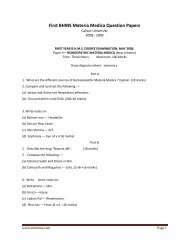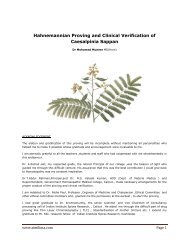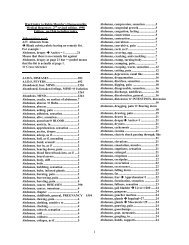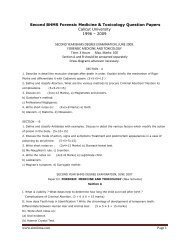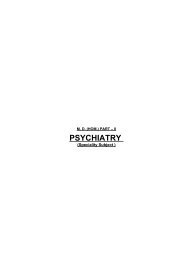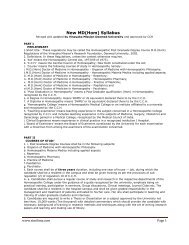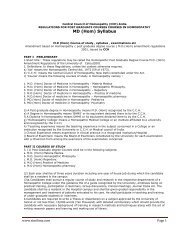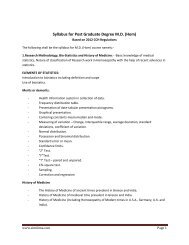KUHS – Kerala University of Health Sciences – MD (Hom - Similima
KUHS – Kerala University of Health Sciences – MD (Hom - Similima
KUHS – Kerala University of Health Sciences – MD (Hom - Similima
You also want an ePaper? Increase the reach of your titles
YUMPU automatically turns print PDFs into web optimized ePapers that Google loves.
21<br />
II. Study <strong>of</strong> homeopathic drugs<br />
1. Study <strong>of</strong> pure effects <strong>of</strong> homeopathic drugs from all sources, books and to interpret the<br />
same<br />
. 2. Study <strong>of</strong> group characteristics with remedy differentiation<br />
3. Study <strong>of</strong> relationship <strong>of</strong> drugs<br />
4. Comparative study <strong>of</strong> Materia Medica<br />
a. Detailed study <strong>of</strong> polychrest drugs with their drug pictures<br />
b. Therapeutic indications <strong>of</strong> all drugs with special reference to rare remedies<br />
III. Practice <strong>of</strong> <strong>Hom</strong>eopathy in Medicine, Surgery, Obstetrics and Gynecology<br />
1. A systematic study <strong>of</strong> common diseases in internal medicine and its homeopathic<br />
management<br />
2. Iatrogenic diseases- its homeopathic management<br />
(III) Repertory:<br />
1. Chronological development <strong>of</strong> repertory from Dr. Hahnemann till now.Their<br />
developmental sources and reference to their methods origin and subsequent development or<br />
edition afterwards with special <strong>of</strong> study and way <strong>of</strong> approach. Study <strong>of</strong> evolution <strong>of</strong> repertory, so<br />
that a comprehensive knowledge can be achieved as (a) Introduction including source and origin<br />
<strong>of</strong> repertory, about writer developments and edition subsequently. (b) Philosophical backgrounds<br />
and fundamentals. (c) Doctrine. (d) Construction (e) Plan (f) Adaptability<br />
From Hahnemann→ Boenninghausen→ Kent→ Boger → Newer repertories →Synthetic→<br />
Synthesis →Complete → Murphy. The critical study <strong>of</strong> these repertories from different angles,<br />
their utility, advantages and disadvantages, scope and limitations<br />
2.Classification <strong>of</strong> repertories into different groups. Use and importance <strong>of</strong> different<br />
groups, Clinical application <strong>of</strong> different repertories in different types <strong>of</strong> cases.<br />
3. Terminology: Meaning <strong>of</strong> different technical terminology in studying repertory as<br />
rubric, subrubric, cross reference, similar rubric, gradation, rank, elimination generalization<br />
particularization and synthesis. Interpretation and analysis <strong>of</strong> terminology used in<br />
Boenninghausen’s, Kent’s, Murphy’s, Synthesis, Kneer’s, Boger’s repertories etc. and their<br />
applications in the light <strong>of</strong> modern knowledge.<br />
4. Symptomatology: Definition, Source, different varieties <strong>of</strong> symptoms, their interrelation<br />
and meaning with each other and value in analysis or anamnesis in a case as given by different<br />
authors till now. Concept <strong>of</strong> totality <strong>of</strong> symptoms and way <strong>of</strong> approach Hahnemann,<br />
Voenninghausen, Kent, Boger, Stuart Close, H.A. Robert and Richard Huges.Boger’s<br />
contribution to symptomatology and its importance.<br />
1. Understanding the study <strong>of</strong> symptomatology in detail along with the Miasmatic understanding.



